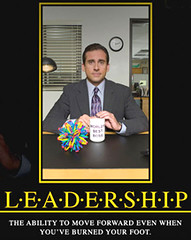Last week, I mentioned a communication breakdown. On the front end, it was confined to the chair and president of the International Association of Business Communicators (IABC), which is a global network of communicators working in diverse industries, and IABC member David Murray, who has his own ideas about what IABC should be doing. Shel Holtz did a good job with the recap so I won’t repeat it. It’s not very entertaining, er, or is it?
If it was an episode of The Office, it would have went something like this…
Dwight: I’m so excited! We have a new Scranton plan and I want to share some of it early! Listen up, everybody; this is going to be great! … Blah, blah, blah.
Toby: Blah, blah, blah? That’s stupid, Dwight. You can’t do it that way. It has to go through corporate.
Dwight: Oh, come on … maybe you just need to hear a little more.
Toby: No, Dwight. I don’t. It’s stupid.
Michael: Hold on. If anyone is going to call Dwight’s plan stupid, they have to call me stupid too. It was my plan.
Toby: Whatever, Michael. It’s still stupid and I’m calling Ryan.
So what really happened?
Todd Hattori, chair of IABC, made the mistake of pre-releasing some strategic plan summaries to the public before the plan was ready for members (let alone the public) because he was enthusiastic about it. Murray, an IABC member with his own ideas about what needs to be done, publicly criticized the summary.
Hattori and Julie Freeman, president of IABC, attempted to respond, trying to defend the unreleased plan by sharing more information. They didn’t need to go beyond adding a comment to Murray’s blog, perhaps asking Murray to wait for the plan to be released. But they did, and that made matters worse. Go figure.
So what could have happened?
IABC could have released the strategic plan to various internal stakeholders, incorporated the best input as needed, and then released the completed plan to the public. Communicating change works best from the inside out.
The Story Continues…
Ragan Communications noted the tussle and thought it would be fun to cover. Last week, I thought it was a good thing that Ragan Communications gave the criticism a forum out of principle. I’m less inclined to think so today, because Ragan appears to have a stake in the outcome. The Ragan a la Michael Klein addition to the non-communication went something like this…
Toby (into phone): Ryan, yeah, it’s Toby, I have a problem.
Ryan: Toby, I’m busy. Let Angela work it out until I can get there.
Angela: Well, this plan doesn’t include Ryan’s ideas, so Toby is right, it’s stupid. But if you want, I’ll be happy to listen …
Michael and Dwight: Okay! Blah, blah, blah.
Angela: Blah, blah, blah? No, it’s definitely stupid. Let’s take a vote.
Ryan’s fans: Whatever Angela says!
So what really happened?
Klein, who also has ideas about what IABC should be doing, first wrote an op-ed mostly highlighting Murray’s point of view and infused some additional points (fair enough). And then, Murray seemed to ask for an objective “interview.” Hattori and Freeman accepted, despite all this being well beyond objectivity.
So what could have happened?
I appreciate that Hattori and Freeman were trying to be responsive, but it came across as somewhat defensive. It certainly did not serve members to make the IABC Strategic Plan the subject matter of a pretend news source. Ragan has some good content, but its flash-in-the-pan style often dilutes its value.
The Story Continues…
About that time, it seems Shel Holtz and I stumbled upon the conversation, both wondering if it was worth commenting on at all. That went something like this…
Jim: Hey, what are we voting on in here?
Kevin: Hey Jim, It’s confusing, but I’ll map it all out for you.
Jim: Sure, map away. It all seems kind of silly.
Michael: Jim, can you define silly?
Dwight: What part’s silly? Mine? Or Toby’s?
Jim: You know, maybe I ought to keep out of it.
Kevin: That might be best. Nobody cares anyway.
Jim: You might be right.
Ryan (finally walking in): Nobody cares? Everybody cares! At least they used to care!
Kevin: Good point, Ryan. Why doesn’t anyone care?
Toby: That was my point all along.
So are there any real issues?
I see several issues buried somewhere in all the bias, but I think even those are trumped by the simple fact that this strategic plan has not been released. As for IABC members not chiming in en masse, I can only guess that most are wise enough to avoid a conversation about something they have not seen, which is why I’m waiting until the strategic plan is released.
Except, I’d like to note that the entire dialogue (and I use that term loosely) was an exercise in non-communication with no more validity than a basic blog drama. You would think that people who are communicators would know better, given they are all professionals. For some reason, everyone treats social media like it somehow supercedes proven communication practices. It does not.

If it was an episode of The Office, it would have went something like this…
Dwight: I’m so excited! We have a new Scranton plan and I want to share some of it early! Listen up, everybody; this is going to be great! … Blah, blah, blah.
Toby: Blah, blah, blah? That’s stupid, Dwight. You can’t do it that way. It has to go through corporate.
Dwight: Oh, come on … maybe you just need to hear a little more.
Toby: No, Dwight. I don’t. It’s stupid.
Michael: Hold on. If anyone is going to call Dwight’s plan stupid, they have to call me stupid too. It was my plan.
Toby: Whatever, Michael. It’s still stupid and I’m calling Ryan.
So what really happened?
Todd Hattori, chair of IABC, made the mistake of pre-releasing some strategic plan summaries to the public before the plan was ready for members (let alone the public) because he was enthusiastic about it. Murray, an IABC member with his own ideas about what needs to be done, publicly criticized the summary.
Hattori and Julie Freeman, president of IABC, attempted to respond, trying to defend the unreleased plan by sharing more information. They didn’t need to go beyond adding a comment to Murray’s blog, perhaps asking Murray to wait for the plan to be released. But they did, and that made matters worse. Go figure.
So what could have happened?
IABC could have released the strategic plan to various internal stakeholders, incorporated the best input as needed, and then released the completed plan to the public. Communicating change works best from the inside out.
The Story Continues…
Ragan Communications noted the tussle and thought it would be fun to cover. Last week, I thought it was a good thing that Ragan Communications gave the criticism a forum out of principle. I’m less inclined to think so today, because Ragan appears to have a stake in the outcome. The Ragan a la Michael Klein addition to the non-communication went something like this…
Toby (into phone): Ryan, yeah, it’s Toby, I have a problem.
Ryan: Toby, I’m busy. Let Angela work it out until I can get there.
Angela: Well, this plan doesn’t include Ryan’s ideas, so Toby is right, it’s stupid. But if you want, I’ll be happy to listen …
Michael and Dwight: Okay! Blah, blah, blah.
Angela: Blah, blah, blah? No, it’s definitely stupid. Let’s take a vote.
Ryan’s fans: Whatever Angela says!
So what really happened?
Klein, who also has ideas about what IABC should be doing, first wrote an op-ed mostly highlighting Murray’s point of view and infused some additional points (fair enough). And then, Murray seemed to ask for an objective “interview.” Hattori and Freeman accepted, despite all this being well beyond objectivity.
So what could have happened?
I appreciate that Hattori and Freeman were trying to be responsive, but it came across as somewhat defensive. It certainly did not serve members to make the IABC Strategic Plan the subject matter of a pretend news source. Ragan has some good content, but its flash-in-the-pan style often dilutes its value.
The Story Continues…
About that time, it seems Shel Holtz and I stumbled upon the conversation, both wondering if it was worth commenting on at all. That went something like this…
Jim: Hey, what are we voting on in here?
Kevin: Hey Jim, It’s confusing, but I’ll map it all out for you.
Jim: Sure, map away. It all seems kind of silly.
Michael: Jim, can you define silly?
Dwight: What part’s silly? Mine? Or Toby’s?
Jim: You know, maybe I ought to keep out of it.
Kevin: That might be best. Nobody cares anyway.
Jim: You might be right.
Ryan (finally walking in): Nobody cares? Everybody cares! At least they used to care!
Kevin: Good point, Ryan. Why doesn’t anyone care?
Toby: That was my point all along.
So are there any real issues?
I see several issues buried somewhere in all the bias, but I think even those are trumped by the simple fact that this strategic plan has not been released. As for IABC members not chiming in en masse, I can only guess that most are wise enough to avoid a conversation about something they have not seen, which is why I’m waiting until the strategic plan is released.
Except, I’d like to note that the entire dialogue (and I use that term loosely) was an exercise in non-communication with no more validity than a basic blog drama. You would think that people who are communicators would know better, given they are all professionals. For some reason, everyone treats social media like it somehow supercedes proven communication practices. It does not.




















